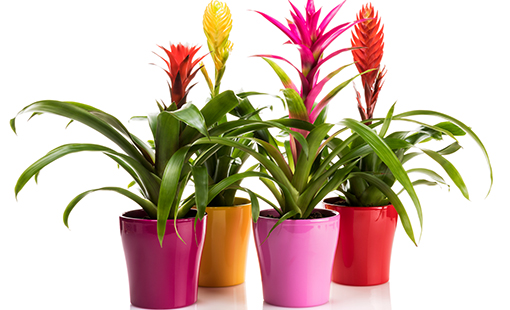
Bromeliads Care & Info
The showy bromeliad may look difficult to grow but it can easily adapt to average home conditions with its astonishing array of colors and textures. Although many do have very splashy flower displays, bromeliads are just as popular as beautiful foliage plants with strappy leaves in red, green, purple, orange and yellow colors and with bands, stripes, spots, and other features. Bromeliads are relatively slow-growing plants that take one to three years to mature into flowering plants.
Care
In general, bromeliads need a fairly specific set of conditions to bloom—and these conditions vary from genus to genus, and even from species to species in a single genus. Their bloom cycle is affected by day length, temperature, humidity, water and feeding. You will need to research specific genera and species to determine how best to grow them.
Bromeliad species can either be terrestrial (grown in soil) or epiphytic (clinging to trees and absorbing nutrients through their leaves), but when grown as houseplants, both types are usually grown in a porous, well-draining potting mixture. As a general rule of thumb, bromeliads will thrive in the same conditions as epiphytic orchids. However, they are considerably more tolerant than orchids of fluctuations in temperature, drought and careless feeding.
When cultivated as indoor plants, most bromeliads—both epiphytic and terrestrial species—are usually planted in a mixture of potting soil and sand. Watering is done either by moistening the soil or by filling the center depression (“cup”) formed by the rosette of leaves.
Light
Different genera of bromeliads are tolerant of different levels of light. Some can withstand full tropical sun, while others will quickly scorch. In general, the varieties with soft, flexible, spineless leaves usually prefer lower light levels, while those with stiff, hard leaves prefer bright indirect light.
Plants that are yellowish might be receiving too much light, while plants that are dark green or elongated might be receiving too little light. Increasing light exposure can help the plant bloom, provided the other conditions are appropriate.
Soil
Bromeliads grown indoors thrive in fast-draining potting soil that holds moisture but drains well. A mixture of two-thirds peat-based soil and one-third sand is often ideal. You can also use orchid mix, charcoal or soilless potting mix. Many bromeliads that are epiphytic can be grown in containers, or you can try to grow them as authentic “air plants” mounted to boards or logs (typically secured with ties or glue).
Water
Bromeliads are very tolerant of drought conditions. In a typical house, it’s usually not necessary to keep the central cup of the plant constantly filled with water. But this is an option if the light levels and temperature are high. If you do centrally water your bromeliad, make sure to flush the central cup every so often to remove any built-up salts. But in general, it’s enough to water these plants very sparingly through the soil weekly during the growing season and reduce watering during the winter rest period. Never let the plant rest in standing water.
Plants you are growing as epiphytes (as air plants without soil) need more consistent watering; drench them once a day, and give them a good soaking by submerging them in water once per week.
Temperature and Humidity
Bromeliads are also highly tolerant of temperature variations, but plants in hotter conditions need more humidity. Bromeliads prefer temperatures between 55 and 80 degrees Fahrenheit. Though some cold-hardy types can survive temperatures down to 20 degrees, they should generally not be exposed to temperatures under 40 degrees. They grow well indoors at humidity levels between 40 percent and 60 percent. In many climates, bromeliads can be moved outdoors during the summer.
Fertilizer
Bromeliads are not heavy feeders. During the growing season, use a liquid fertilizer diluted at one-eighth or one-quarter strength, applied every two to four weeks. If you use a slow-release pellet fertilizer, apply a single pellet once each season when watering the central cup. Avoid feeding mature plants in winter or when the plant begins to flower.
Common Pests & Diseases
Although sometimes susceptible to mealybugs, aphids and scale, bromeliads are largely free of severe pests and diseases. But they can be prone to some cultural issues:
- Overwatering: If mistakenly watered by over-saturating the potting soil rather than filling the central “cup” formed by the leaves, bromeliads can develop rot. These are plants that like relatively dry conditions.
- Hard water: Water high in mineral content can cause water spots on the base of the plant and in the center cup. It is best to water with demineralized water.
- Improper container: Bromeliads don’t have a large root system, so plant them in small, well-draining pots that won’t collect a lot of water, which can lead to rot.
How to Get Bromeliads to Bloom
While it can be difficult to accurately replicate the conditions any particular bromeliad needs to bloom, some research has shown the plants can be forced to bloom by exposure to ethylene gas. So if you want to force your plant to spike, place it in a tightly sealed, clear plastic bag for up to 10 days with a ripe apple. The apple will give off ethylene gas as it decomposes. Make sure any water is drained from the bromeliad’s central cup before attempting this.
FAQ
- Are bromeliads easy to care for?
These showy plants may look high-maintenance but they require little help to thrive. Luckily, their leaves do a lot of the work by absorbing moisture and other nutrients from the air. - How fast does a bromeliad grow?
Bromeliads are slow-growers and can take from one to three years to mature into blooming plants. - How long can a bromeliad live?
Most indoor bromeliads can live between two to five years before the mother plant dies.
Information courtesy of TheSpruce.com

 Adams Fairacre Farms
Adams Fairacre Farms